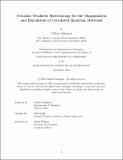Ultrafast Terahertz Spectroscopy for the Manipulation and Elucidation of Correlated Quantum Materials
Author(s)
Allington, Clifford
DownloadThesis PDF (44.92Mb)
Advisor
Gedik, Nuh
Terms of use
Metadata
Show full item recordAbstract
Light-matter interactions are at the heart of quantum mechanics. The photoelectric effect, blackbody radiation, and the hydrogen emission spectrum were all experimental observations using light and its interaction with matter which led to the discovery of the quantum mechanical nature of the universe. In modern research, the interactions of light with matter plays a significant role in both understanding the properties of, or controlling various aspects of quantum materials, a class of materials whose macroscopic properties are only understood through quantum mechanics. Quantum materials are often categorized into two classes: topological materials or strongly correlated materials, though the cross-over and interplay between these two aspects is a significant field of study as well. Strongly correlated materials exhibit exotic physical phases such as magnetism, superconductivity, or heavy fermion formation due to the strong interactions of electrons. Many of these properties hold significant promise for application, yet the ability to predict correlated physics from a theoretical standpoint is still at a young stage of development. To this end, experimental efforts to demonstrate and understand the interplay between different degrees of freedom in a material (spin, charge, lattice, and orbital) are essential for progressing in this direction.
In this thesis, a variety of light-matter interactions using ultrafast techniques are explored in a set of quasi two-dimensional strongly correlated materials. These are bulk materials, whose properties are strongly founded in the two-dimensional layers stacked on top of one another. A variety of Optical-Pump Terahertz-Probe spectroscopic methods are used to drive a system out of equilibrium while monitoring the low-energy physics in the terahertz (THz) spectral range. This part of the electromagnetic spectrum is essential to understanding many aspects of strongly correlated physics. For example, the charge carriers in a metallic (or photoexcited) material have a strong spectral weight here and many of the collective modes of insulating phases, such as phonons or magnons, occur at these energies as well. Specifically, the collective modes of two van der Waals antiferromagnets are excited coherently with the use of ultrafast optical pulses. In the antiferromagnet NiPS3 a new mechanism for launching a coherent magnon is discovered. In the multiferroic, antiferromagnet NiI2, evidence for a new type of quasiparticle, an electromagnon-polariton, is demonstrated in a non-equilibrium sample. Further, preliminary data regarding the measurement of a new type of Kondo hybridization gap (a pseudogap) in the kagome strange metal Ni3In is reported using the photoexcited dynamics and the Rothwarf-Taylor bottleneck model.
Date issued
2024-09Department
Massachusetts Institute of Technology. Department of ChemistryPublisher
Massachusetts Institute of Technology